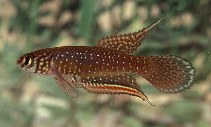| Family: |
Rivulidae (Rivulines), subfamily: Cynolebiinae |
| Max. size: |
8 cm TL (male/unsexed) |
| Environment: |
benthopelagic; freshwater; pH range: 6.5 - 7; dH range: 5 - 8, non-migratory |
| Distribution: |
South America: Laguna de Araruama basin, Das Ostras River basin, coastal plains adjacent to the mouth of São João River in Brazil. |
| Diagnosis: |
Dorsal spines (total): 0-0; Dorsal soft rays (total): 13-19; Anal spines: 0-0; Anal soft rays: 18-24; Vertebrae: 29-31. Having series of small bluish white spots, often coalesced to form continuous or fragmented line, on subdistal area of caudal fin and dark brown to black stripe on border of anal fin, adjacent and parallel to perpendicular extensions of subdistal golden transverse lines. Dorsal head profile slightly convex to nearly straight in male, gently concave to approximately straight in female (Ref. 42934). |
| Biology: |
Occurs in small freshwater temporary pools in floodplains of streams and lagoons. These pools are shallow with compact, soft reddish brown muddy bottom and dry twice a year, during winter, usually from July to August, and during summer, usually from February to March. During dry season, all fish die and eggs undergo in diapause within the substrate. Eclosion happens at the onset of wet season, usually March-April and September-October (Ref. 42934). This species was introduced in California (Ref. 4357). Bottom spawner, 4 months incubation. Is easy to maintain in the aquarium (Ref. 27139). |
| IUCN Red List Status: |
Endangered (EN); Date assessed: 18 May 2022 (B1ab(i,ii,iii,iv,v)+2ab(i,ii,iii,iv,v)) Ref. (130435)
|
| Threat to humans: |
harmless |
Source and more info: www.fishbase.org. For personal, classroom, and other internal use only. Not for publication.

